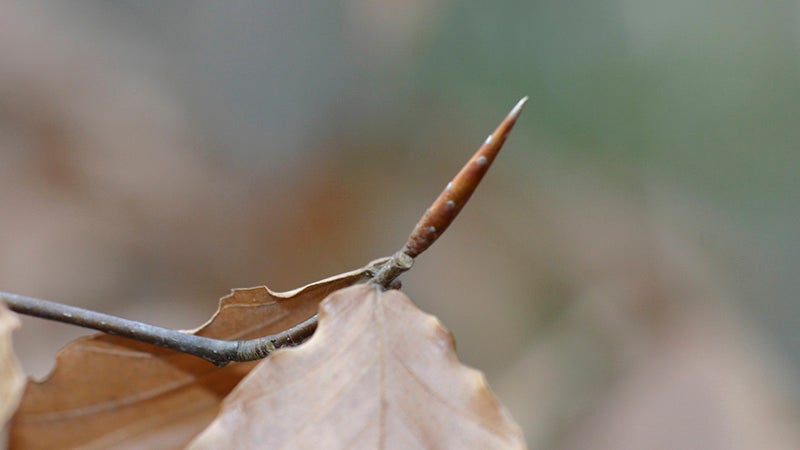Native plants for your winter landscape
Published 7:00 am Wednesday, December 19, 2018

- Pictured is an American Beech tree bud. Submitted photo
By Patricia R. Drackett, Director and Assistant Extension Professor of Landscape Architecture
The Crosby Arboretum, Mississippi State University Extension Service
The recent overcast days have highlighted the subtle colors and patterns in the Crosby Arboretum landscape, causing the golds, rusts, and scarlets of winter foliage to really stand out against the subdued hues of the forest!
Curator Jennifer Buchanan has remarked on how brilliant the fall leaves have been this season, and perhaps you’ve noticed this, too. Trees such as cypress, red maple, sweetgum, and oak offer some excellent fall color that persists late into the season.
Although we think of spring as the premier planting season, when we are stirred by the warm weather by the irresistible urge to garden, take advantage of the winter months in coastal Mississippi, which offer many comfortable days to be outside installing new plants. Warm winter days are not only an excellent time to be outdoors, but promote new root growth, allowing new plants to become established before summer weather.
One plant that sports a bright crimson or burgundy fall color is Elliot’s blueberry (Vaccinium elliotii), which virtually glows in the landscape. Locals call this native shrub, as well as its relatives, a “huckleberry”. Although it will occur in a shady understory, having sun will promote the best fall color.
Growing to around six to eight feet in height, Elliot’s blueberry has an open, lacy form and delicate green branches that make it an attractive addition to your garden. The shrub reminds me a bit of Nandina. Tiny bell-shaped blossoms appear in spring, sometimes as early as January, making this blueberry one of the earlier plants to bloom in the winter months. Bees and other insects seeking nectar find its flowers irresistible.
Now that most trees have shed their leaves, visitors comment on other aspects of plants in our exhibits, such as the plump buds on native azaleas. Personally, I’m always enthralled by the brown pendulous leaves that cling to our American beech trees throughout the winter, until they are pushed off by newly emerging leaves.
Without leaves to hide the trunks and detract one’s attention, tree bark is now much more obvious on a walk through our grounds. Lichens decorate the trunks of the American holly growing next to our deck at the Visitor Center. Other smooth-trunked trees such as red maple and sweetbay magnolia also sport lichen growth.
If you have a nature-lover in the family, consider getting them a book on identifying trees by their bark. Together, learn to recognize and appreciate the bark of our local trees, such as the scaly bark of longleaf pine, which provides protection against fire, the smooth bark of American beech, the blocky bark of persimmon, and the furrowed bark of sweetgum.
We have some great events and programs planned for winter! See our program calendar on the website or pick up a copy at the Visitor Center. Mark your calendar for our annual Forge Day on Saturday, January 26 from 10:00 a.m. to 2:00 p.m., which will include Lyle Wynn of Brandon, Mississippi, a recent competitor on the History Channel’s “Forged in Fire” series.
A children’s workshop on making Sock Caterpillars takes place on Saturday, January 5 from 10:00 to 11:00 a.m. Come enjoy the return of this popular workshop with Kim Johnson. Members $4 per child; non-member $6. No charge for adults. That same afternoon, enjoy Family Bingo from 2:00 to 3:00 p.m., a fun way for families to spend time together. There will be prizes for all ages, so bring a friend. Members $2 per person; non- members $3. Both programs include snacks and refreshments.
On Saturday, January 12, from 10:00 to 11:00 a.m., attend a program on Controlling Feral Hogs, a non-native, invasive species which are spreading at an alarming rate and presenting serious issues for property owners. Learn about the types of damage these nuisance wildlife cause and the variety of control options available with Pearl River County Extension Agent Dr. Eddie Smith. The program is free to all. Call 601-799-2311 to sign up.
Consider giving a membership to the Arboretum as a gift. Our memberships offer unlimited visits to our public garden, and free or reduced admission to over 300 other gardens in North America, through the American Horticultural Society’s Reciprocal Membership Program. A year membership is $35 for an individual, $30 for senior/military, and $45 for a family membership (and $20 for students!).
See www.crosbyarboretum.msstate.edu or visit the Crosby Arboretum Facebook page for more information on programs and activities. We’re open Wednesday through Sunday from 9 to 5. Leashed pets welcome. The Arboretum is located at 370 Ridge Road in Picayune, at I-59 Exit 4.



